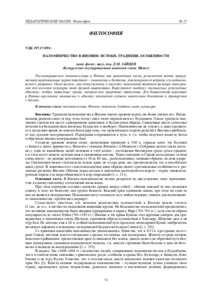Please use this identifier to cite or link to this item:
https://elib.psu.by/handle/123456789/24239Full metadata record
| DC Field | Value | Language |
|---|---|---|
| dc.contributor.author | Зайцев, Д. М. | - |
| dc.date.accessioned | 2020-01-17T11:46:44Z | - |
| dc.date.available | 2020-01-17T11:46:44Z | - |
| dc.date.issued | 2019 | - |
| dc.identifier.citation | Вестник Полоцкого государственного университета. Серия E, Педагогические науки. - 2019. - № 15. - С. 71-76. | ru_RU |
| dc.identifier.uri | https://elib.psu.by/handle/123456789/24239 | - |
| dc.description | Pilgrimage in Japan: Origins, Traditions, Features D. Zaitsev | ru_RU |
| dc.description.abstract | Рассматривается паломничество в Японии как важнейшая часть религиозной жизни приверженцев традиционных вероисповеданий – синтоизма и буддизма. Анализируются вопросы его возникновения и развития. Отмечается, что деятельность и наследие паломников являются важным материалом для изучения культуры этой древней цивилизации. Выделяются наиболее посещаемые религиозные объекты: особые священные храмы, захоронения, природные святилища. Для большинства верующих в Японии трепетное отношение к объекту поклонения служит накоплению благодати и примирению с духами.= The article considers the Japanese pilgrimage as an essential part of the religious life of adherents of traditional religions of Japan, Shintoism and Buddhism. The questions of the origin and development of this phenomenon are analyzed. Numerous examples show the diversity of pilgrimages in Japan. It is noted that the activities and heritage of the pilgrims are important material for studying the culture of this ancient civilization. The most visited religious sites are distinguished: special sacred temples, burials, natural sanctuaries. For tens of millions of believers in Japan, a reverent attitude towards the object of worship serves the accumulation of grace and reconciliation with spirits. The purpose of the study is to identify the features of the Japanese pilgrimage, to show the influence of historical, geographical, cultural factors on their formation. This work may be useful for solving pressing problems of interaction with representatives of the world of Japanese civilization. | ru_RU |
| dc.language.iso | ru | ru_RU |
| dc.publisher | Полоцкий государственный университет | ru_RU |
| dc.relation.ispartof | Веснік Полацкага дзяржаўнага ўніверсітэта. Серыя E, Педагагічныя навукі | be_BE |
| dc.relation.ispartof | Herald of Polotsk State University. Series E, Pedagogical Sciences | en_EN |
| dc.relation.ispartof | Вестник Полоцкого государственного университета. Серия E, Педагогические науки | ru_RU |
| dc.relation.ispartofseries | Серия E, Педагогические науки;2019. - № 15 | - |
| dc.rights | open access | ru_RU |
| dc.subject | Государственный рубрикатор НТИ - ВИНИТИ::ОБЩЕСТВЕННЫЕ НАУКИ::Философия | ru_RU |
| dc.subject | Паломничество | ru_RU |
| dc.subject | Япония | ru_RU |
| dc.subject | Синтоизм | ru_RU |
| dc.subject | Буддизм | ru_RU |
| dc.subject | Ками | ru_RU |
| dc.subject | Культура | ru_RU |
| dc.subject | Pilgrimage | ru_RU |
| dc.subject | Japan | ru_RU |
| dc.subject | Shintoism | ru_RU |
| dc.subject | Buddhism | ru_RU |
| dc.subject | Kami | ru_RU |
| dc.subject | Culture | ru_RU |
| dc.title | Паломничество в Японии: истоки, традиция, особенности | ru_RU |
| dc.type | Article | ru_RU |
| dc.identifier.udc | УДК 297.17(091) | - |
| Appears in Collections: | 2019, № 15 | |
Items in DSpace are protected by copyright, with all rights reserved, unless otherwise indicated.
